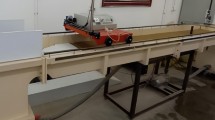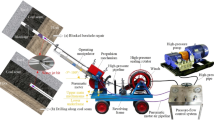Abstract
The Lanzhou-Xinjiang High-speed Railway runs through an expansive windy area in a Gobi Desert, and sand-blocking fences were built to protect the railway from destruction by wind-blown sand. However, the shielding effect of the sand-blocking fence is below the expectation. In this study, effects of metal net fences with porosities of 0.5 and 0.7 were tested in a wind tunnel to determine the effectiveness of the employed two kinds of fences in reducing wind velocity and restraining wind-blown sand. Specifically, the horizontal wind velocities and sediment flux densities above the gravel surface were measured under different free-stream wind velocities for the following conditions: no fence at all, single fence with a porosity of 0.5, single fence with a porosity of 0.7, double fences with a porosity of 0.5, and double fences with a porosity of 0.7. Experimental results showed that the horizontal wind velocity was more significantly decreased by the fence with a porosity of 0.5, especially for the double fences. The horizontal wind velocity decreased approximately 65% at a distance of 3.25 m (i.e., 13H, where H denotes the fence height) downwind the double fences, and no reverse flow or vortex was observed on the leeward side. The sediment flux density decreased exponentially with height above the gravel surface downwind in all tested fences. The reduction percentage of total sediment flux density was higher for the fence with a porosity of 0.5 than for the fence with a porosity of 0.7, especially for the double fences. Furthermore, the decreasing percentage of total sediment flux density decreased with increasing free-stream wind velocity. The results suggest that compared with metal net fence with a porosity of 0.7, the metal net fence with a porosity of 0.5 is more effective for controlling wind-blown sand in the expansive windy area where the Lanzhou-Xinjiang High-speed Railway runs through.
Similar content being viewed by others
References
Baltaxe R. 1967. Air flow patterns in the lee of model windbreaks. Theoretical and Applied Climatology, 15(3): 287–312.
Bean A, Alperi R W, Federer C A. 1975. A method for categorizing shelterbelt porosity. Agricultural Meteorology, 14(1–2): 417–429.
Cheng J J. 2012. Study on the wind-sand flow movement characteristics and the shielding effect of the wind-break wall along the railway in Gobi Area. Applied Mechanics and Materials, 178–181: 1653–1657.
Cheng J J, Xue C X. 2014. The sand-damage-prevention engineering system for the railway in the desert region of the Qinghai-Tibet plateau. Journal of Wind Engineering and Industrial Aerodynamics, 125: 30–37.
Cheng J J, Jiang F Q, Xue C X, et al. 2015. Characteristics of the disastrous wind-sand environment along railways in the Gobi area of Xinjiang, China. Atmospheric Environment, 102: 344–354.
Cheng J J, Lei J Q, Li S Y, et al. 2016. Disturbance of the inclined inserting-type sand fence to wind-sand flow fields and its sand control characteristics. Aeolian Research, 21: 139–150.
Cornelis W M, Gabriels D. 2005. Optimal windbreak design for wind-erosion control. Journal of Arid Environments, 61(2): 315–332.
Dong Z B, Liu X P, Wang X M. 2002. Aerodynamic roughness of gravel surfaces. Geomorphology, 43(1–2): 17–31.
Dong Z B, Chen G T, He X D, et al. 2004. Controlling blown sand along the highway crossing the Taklimakan Desert. Journal of Arid Environments, 57(3): 329–344.
Dong Z B, Qian G Q, Luo W Y, et al. 2006. Threshold velocity for wind erosion: the effects of porous fences. Environmental Geology, 51(3): 471–475.
Dong Z B, Luo W Y, Qian G Q, et al. 2007. A wind tunnel simulation of the mean velocity fields behind upright porous fences. Agricultural and Forest Meteorology, 146(1–2): 82–93.
Dong Z B, Lv P, Zhang Z C, et al. 2012. Aeolian transport in the field: A comparison of the effects of different surface treatments. Journal of Geophysical Research: Atmospheres, 117(D9): D09210.
Lee S J, Kim H B. 1998. Velocity field measurements of flow around a triangular prism behind a porous fence. Journal of Wind Engineering and Industrial Aerodynamics, 77–78(98): 521–530.
Lee S J, Kim H B. 1999. Laboratory measurement of velocity and turbulence field behind porous fences. Journal of Wind Engineering and Industrial Aerodynamics, 80(3): 311–326.
Lee S J, Park K C, Park C W. 2002. Wind tunnel observations about the shelter effect of porous fences on the sand particle movements. Atmospheric Environment, 36(9): 1453–1463.
Li B L, Sherman D J. 2015. Aerodynamics and morphodynamics of sand fences: A review. Aeolian Research, 17: 33–48.
Li G S, Qu J J, Li X Z, et al. 2013. The effect of microclimates in the aeolian sand environment at the Mogao Grottoes, China. Terrestrial Atmospheric and Oceanic Sciences, 24(1): 89–105.
Li G S, Qu J J, Li X Z, et al. 2014. The sand-deposition impact of artificial gravel beds on the protection of the Mogao Grottoes. Scientific Reports, 4: 4341.
Ling Y Q, Jin J, Zou B G, et al. 1984. Effect of fence techniques in levelling sand accumulation around sandbreaks—Case study in Shapotou district. Journal of Desert Research, 1984, 4(3): 16–25. (in Chinese)
Ling Y Q, Qu J J, Fan J S, et al. 1996. The effect analysis of sand control engineering on the cliff top of Mogao Grottoes. Journal of Desert Research, 16(1): 13–18. (in Chinese).
Lv P, Dong Z B. 2014. The status of research on the development and characteristics of mass-flux-density profiles above wind-eroded sediments: a literature review. Environmental Earth Sciences, 71(12): 5183–5194.
Lv P, Dong Z B, Ma X M. 2016. Aeolian sand transport above three desert surfaces in northern China with different characteristics (shifting sand, straw checkerboard, and gravel): field observations. Environmental Earth Sciences, 75(7): 1–9.
Plate E J. 1971. The aerodynamics of shelter belts. Agricultural Meteorology, 8: 203–222.
Qu J J, Huang N, Ta W Q, et al. 2005. Structural characteristics of Gobi sand-drift and its significance. Advances in Earth Science, 20(1): 19–23. (in Chinese)
Raine J K, Stevenson D C. 1977. Wind protection by model fences in a simulated atmospheric boundary layer. Journal of Wind Engineering and Industrial Aerodynamics, 2(2): 159–180.
Tan L H, Zhang W M, Qu J J, et al. 2013. Aeolian sand transport over Gobi with different gravel coverages under limited sand supply: A mobile wind tunnel investigation. Aeolian Research, 11: 67–74.
Wang W F, Wang T, Fan J S, et al. 2005. Effect of nylon net fence on preventing blown sand at top of Mogao Grottoes, Dunhuang. Journal of Desert Research, 25(5): 640–648. (in Chinese)
White B R. 1996. Laboratory simulation of Aeolian sand transport and physical modeling of flow around dunes. Annals of Arid Zone, 35(3): 187–213.
Zhang K C, Qu J J, Liao K T, et al. 2010. Damage by wind-blown sand and its control along Qinghai-Tibet Railway in China. Aeolian Research, 1(3–4): 143–146.
Zhou D, Yuan X X, Yang M Z, et al. 2012. Research on the anti-wind/sand effect of windbreak wall on high-speed train. Journal of Experiments in Fluid Mechanics, 24(4): 63–67. (in Chinese)
Acknowledgements
This research was financially supported by the Scientific and Technological Services Network Planning Project of Northwest Institute of Eco-Environment and Resources, Chinese Academy of Sciences (HHS-TSS-STS-1504), the Technological Research and Developmental Planning Projects of China Railway Corporation (2015G005-B), and the National Natural Science Foundation of China (41501010, 41401611).
Author information
Authors and Affiliations
Corresponding author
Rights and permissions
About this article
Cite this article
Wang, T., Qu, J., Ling, Y. et al. Wind tunnel test on the effect of metal net fences on sand flux in a Gobi Desert, China. J. Arid Land 9, 888–899 (2017). https://doi.org/10.1007/s40333-017-0068-5
Received:
Revised:
Accepted:
Published:
Issue Date:
DOI: https://doi.org/10.1007/s40333-017-0068-5




